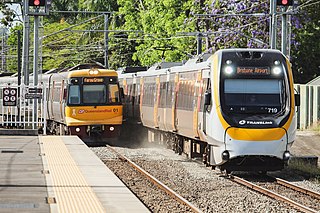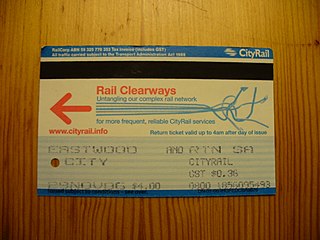
Rail transport in Australia is a component of the Australian transport system. It is to a large extent state-based, as each state largely has its own operations, with the interstate network being developed ever since Australia's federation in 1901. As of 2022, the Australian rail network consists of a total of 32,929 kilometres (20,461 mi) of track built to three major track gauges: 18,007 kilometres (11,189 mi) of standard gauge, 2,685 kilometres (1,668 mi) of broad gauge, and 11,914 kilometres (7,403 mi) of narrow gauge lines. Additionally, about 1,400 kilometres (870 mi) of 610 mm / 2 ft gauge lines support the sugar-cane industry. 3,488 kilometres (2,167 mi), around 11 per cent of the Australian heavy railways network route-kilometres are electrified.

The Rail Clearways Programme was conceived in 2004 with the aim of easing congestion of Sydney's suburban railway network, by reducing the amount of infrastructure shared by multiple services. The disparate projects at pinch points throughout the network were designed to increase passenger capacity and improve reliability. All projects were delivered by the Transport Construction Authority until it was subsumed in November 2011 by Transport for New South Wales. A new timetable was introduced in October 2013 that realised the benefit of many of the projects, and by January 2014—the programme was complete.

Glenfield railway station is a junction station serving the Sydney suburb of Glenfield in Australia. It is served by Sydney Trains T8 Airport & South, T2 Inner West & Leppington and T5 Cumberland line services, and by limited NSW TrainLink Southern Highlands Line services.

Ingleburn railway station is located on the Main Southern line, serving the Sydney suburb of Ingleburn. It is served by Sydney Trains T8 Airport & South line services.

The Australian Rail Track Corporation (ARTC) is an Australian Government-owned statutory corporation.

The Dry Creek–Port Adelaide railway line is an eight-kilometre east–west freight railway line running through Adelaide's north-western suburbs. The line is managed by the Australian Rail Track Corporation (ARTC) and is an important link between Port Adelaide, Pelican Point and the main interstate rail routes which link Adelaide with Melbourne, Perth, Darwin and Sydney. Prior to 1988, a limited local passenger service operated, stopping at five intermediate stations along the line. Since May 1988, the line has been freight-only.
AusLink is a former Government of Australia land transport funding program, that operated between June 2004 and 2009. The former program was administered by the former Department of Transport and Regional Services. In 2009, the program was replaced with the Nation Building Program under the Nation Building Program Act 2009. The Nation Building Program was administered by the Department of Infrastructure and Transport and that program was replaced by The National Land Transport Network, as determined by the Minister for Infrastructure and Regional Development under the National Land Transport Act 2014.

The Sydney Freight Network is a network of dedicated railway lines for freight in Sydney, Australia, linking the state's rural and interstate rail network with the city's main yard at Enfield and Port Botany. Its primary components are the Southern Sydney Freight Line (SSFL) and a line from Sefton to Enfield and Port Botany. The Network has been managed by the Australian Rail Track Corporation (ARTC) since 2012. Prior to the completion of the SSFL, it was managed by RailCorp as the Metropolitan Freight Network.

Sydney, the largest city in Australia, has an extensive network of passenger and freight railways. The passenger system includes an extensive suburban railway network, operated by Sydney Trains, a metro network and a light rail network. A dedicated freight network also exists. Future expansion of the light rail network includes the Parramatta Light Rail. Existing light rail services are the Inner West Light Rail and the CBD & South East Light Rail.

Inland Rail is a 1600-kilometre (990 mi) railway line under construction in Australia. Once complete, it will connect the Melbourne and Brisbane along a new route inland through Victoria, New South Wales and Queensland that allows for the use of double-stacked freight trains.

The South West Rail Link is a railway line serving the developing suburbs of south-western Sydney, Australia between Glenfield and Leppington. Services form part of the Sydney Trains commuter rail network. It opened on 8 February 2015.

VicTrack, trading as the Victorian Rail Track Corporation, is a Victorian Government state-owned enterprise which owns all railway and tram lines, associated rail lands and other rail-related infrastructure in the state of Victoria, Australia, with the exception of the Emerald Tourist Railway Board's heritage Puffing Billy Railway.
One Nation was an Australian Government program of infrastructure development carried out under the Keating Government from 1991 to 1996. Much of the program was implemented as a means of stimulating the economy in the aftermath of the early 1990s recession.
The Sydney–Melbourne rail corridor is approximately 953-kilometre (592-mile) standard-gauge railway corridor that runs between Sydney and Melbourne (Victoria), the two largest cities in Australia. Freight and passenger services operate along the route, including the NSW TrainLink XPT passenger service.
The Adelaide–Port Augusta railway line is the main route for northbound rail traffic out of Adelaide, South Australia. The line, 315 kilometres long, is part of the Adelaide–Darwin rail corridor and the Sydney–Perth rail corridor.

The Northern Sydney Freight Corridor (NSFC) was a project to improve access between Sydney and Newcastle for freight trains. Frequent passenger services operate on the Main Northern line between Strathfield and Broadmeadow. These passenger services take priority, meaning freight trains can be delayed and are subject to a curfew during peak hours. The Northern Sydney Freight Corridor aimed to reduce delays and increase capacity by providing additional train paths. The delivery of the NSFC projects was managed by Transport for NSW, with the exception of the Hexham freight loop which was delivered in June 2012 by the Australian Rail Track Corporation. The final stage was completed in June 2016.

The Inner West & Leppington Line is a commuter rail service currently operated by Sydney Trains, serving the inner west and south-western regions of Sydney, Australia. Consisting of 37 stops, the service commences from the City Circle, then heads west to Granville. The line branches at this point; services either head northwest to Parramatta or south to Leppington. A third terminus at Homebush is used when the part-time Parramatta branch isn't operating. The line commenced operations on 26 November 2017, replacing the T2 Airport, Inner West & South Line.

The Western Sydney Freight Line (WSFL) is a proposed freight railway line between the Main Western railway line at St Marys and the Southern Sydney Freight Line (SSFL) at Villawood, via a new intermodal terminal near Eastern Creek. The NSW Government committed to establishing a corridor for the future WSFL as part of its Freight & Ports Strategy in 2013. Corridor preservation for the WSFL is also considered a priority under the State Infrastructure Strategy. Constraints analysis and consultation took place between 2015 and 2017, with the line in operation "before 2030". The project is expected to cost in the order of $1 billion.
The Holsworthy railway line was located in South-western Sydney. It was constructed during World War I, mainly using labour from the Holsworthy Internment Camp. Its purpose was to service the Holsworthy army facilities opening on 21 January 1918.
The 2010s saw many developments relating to transport in the Australian city of Sydney, New South Wales. The decade saw a substantial investment in infrastructure, including a new airport, motorway projects, light rail lines, Australia's first metro system, the new Waratah fleet and the demise of the non-air conditioned S sets from the rail network. Planning and branding of public transport services became substantially more centralised.















